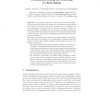Free Online Productivity Tools
i2Speak
i2Symbol
i2OCR
iTex2Img
iWeb2Print
iWeb2Shot
i2Type
iPdf2Split
iPdf2Merge
i2Bopomofo
i2Arabic
i2Style
i2Image
i2PDF
iLatex2Rtf
Sci2ools
ICALP
2001
Springer
2001
Springer
Permutation Editing and Matching via Embeddings
Abstract. If the genetic maps of two species are modelled as permutations of (homologous) genes, the number of chromosomal rearrangements in the form of deletions, block moves, inversions etc. to transform one such permutation to another can be used as a measure of their evolutionary distance. Motivated by such scenarios, we study problems of computing distances between permutations as well as matching permutations in sequences, and finding most similar permutation from a collection (“nearest neighbor”). We adopt a general approach: embed permutation distances of relevance into well-known vector spaces in an approximately distance-preserving manner, and solve the resulting problems on the well-known spaces. Our results are as follows: – We present the first known approximately distance preserving embeddings of these permutation distances into well-known spaces. – Using these embeddings, we obtain several results, including the first known efficient solution for approximately...
ICALP 2001 | Permutation | Permutation Distances | Permutation Matching Problems | Programming Languages |
| Added | 29 Jul 2010 |
| Updated | 29 Jul 2010 |
| Type | Conference |
| Year | 2001 |
| Where | ICALP |
| Authors | Graham Cormode, S. Muthukrishnan, Süleyman Cenk Sahinalp |
Comments (0)

